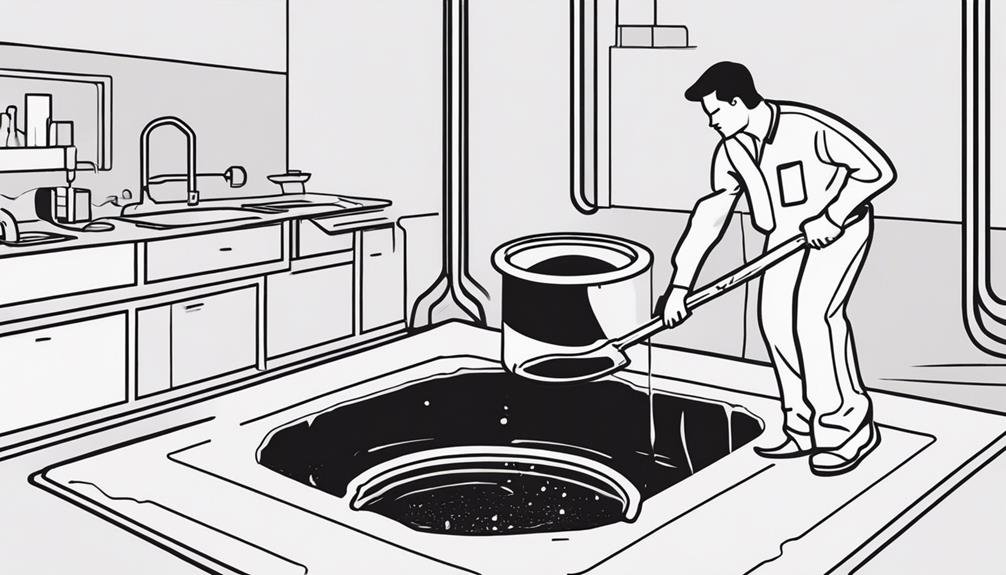Ever wondered if taking care of your septic tank could be simpler than you think?
Many homeowners overlook the importance of proper maintenance, but did you know that with a few key tips, you can potentially avoid costly repairs and ensure your septic system functions efficiently for years to come?
By incorporating some straightforward practices into your routine, you might be surprised at how manageable septic tank care can be.
So, where should you start?
Key Takeaways
- Schedule regular pumping every 3-5 years for optimal system function.
- Use septic-safe products and practice water conservation to maintain balance.
- Opt for eco-friendly cleaning solutions to avoid disrupting the tank's bacteria balance.
- Monitor for signs of a full tank like slow drainage, odors, or sewage backup.
Understanding Your Septic Tank

To properly maintain your septic tank, it's essential to have a clear understanding of its function and structure. Understanding the anatomy of your septic tank is the first step. A typical septic tank consists of two main parts: the tank itself and the drainage field. The tank is where the initial treatment of wastewater occurs. It separates solids from liquids, allowing the solids to settle at the bottom while the lighter scum floats to the top. This process helps prevent clogging of the drainage field.
The drainage field, also known as the leach field, is where the liquid effluent from the septic tank is further treated as it percolates through the soil. This area plays a crucial role in the final treatment of the wastewater before it returns to the groundwater. Proper maintenance of both the tank and the drainage field is essential to ensure the longevity and efficiency of your septic system. Understanding how these components function together will help you make informed decisions when it comes to maintenance and troubleshooting.
Regular Maintenance Practices
Understanding the anatomy of your septic tank lays the groundwork for implementing effective regular maintenance practices to ensure its optimal performance and longevity. To keep your septic system running smoothly, here are some key maintenance practices you should follow:
- Schedule Regular Pumping: Arrange for your septic tank to be pumped every 3-5 years, depending on household size and water usage.
- Conduct DIY Inspections: Regularly check for any signs of leaks, odors, or standing water in the drain field to catch potential issues early.
- Practice Water Conservation: Be mindful of water usage to prevent overloading the septic system and ensure proper treatment.
- Use Septic-Safe Products: Opt for septic-safe toilet paper, cleaning products, and detergents to maintain a healthy balance of bacteria in the tank.
- Be Mindful of What Goes In: Avoid flushing non-biodegradable items, chemicals, grease, and excessive solids down the drain to prevent clogs and damage.
Safe Cleaning Techniques

Are you looking to maintain a clean and efficient septic system with safe cleaning techniques? Keeping your septic tank clean is essential for its proper functioning. When cleaning your septic tank, opt for eco-friendly solutions to minimize harm to the environment. Avoid using harsh chemicals that can disrupt the natural balance within the tank. Instead, consider using natural alternatives like baking soda, vinegar, or enzyme-based cleaners. These options are effective in breaking down waste while being gentle on the system.
When cleaning your septic tank, it's crucial to follow proper disposal techniques. Never dispose of non-biodegradable items, grease, or large quantities of chemicals down the drains, as these can clog the system and disrupt the wastewater treatment process. Implementing good habits in what goes down your drains can significantly reduce the frequency of cleanings needed for your septic tank. By adopting eco-friendly cleaning solutions and proper disposal techniques, you can ensure the longevity and efficiency of your septic system.
Signs Your Tank Needs Pumping
When maintaining your septic system with safe cleaning techniques, it's crucial to be aware of the signs indicating that your tank needs pumping. Regular pumping is essential to prevent backups and maintain a healthy septic system.
Here are some warning signs that suggest your septic tank is due for pumping:
- Slow Draining Fixtures: If you notice slow drainage in sinks, showers, or toilets, it could be a sign that your septic tank is full and needs pumping.
- Foul Odors: Unpleasant smells around your yard or near the drain field indicate that your tank isn't functioning correctly and needs attention.
- Pooling Water: Puddles of water forming around the septic tank or drain field could mean that the tank is full and needs to be pumped.
- Sewage Backup: If sewage starts backing up into your home through drains or toilets, it's a clear sign that your septic tank is full and needs immediate pumping.
- Lush Grass: While it may seem counterintuitive, unusually green and lush grass over the drain field can indicate a problem with the septic system, potentially needing pumping.
Being attentive to these warning signs and adhering to a regular pumping frequency will help maintain your septic system's efficiency and prevent costly repairs.
Frequently Asked Questions
Can I Use Homemade Cleaning Solutions to Maintain My Septic Tank?
You can use homemade cleaning solutions to maintain your septic tank, but be cautious. While natural alternatives are gentle, some commercial products work effectively too. Consider professional services if unsure about DIY methods.
Is It Necessary to Have My Septic Tank Inspected by a Professional Regularly?
Regular DIY inspection of your septic tank offers insights into its health, identifying issues early. While professional maintenance incurs costs, the benefits lie in expert care, ensuring optimal functioning and avoiding costly repairs down the line.
Are There Any DIY Methods for Preventing Septic Tank Odors?
To control septic tank odors naturally, you can try DIY septic tank deodorizers. These home remedies are effective in keeping your system smelling fresh without harsh chemicals. Give them a try for a fresher environment.
How Can I Safely Dispose of Household Chemicals to Prevent Damage to My Septic Tank?
When disposing of household chemicals, ensure safe disposal to prevent septic tank damage. Opt for eco-friendly chemical alternatives. Proper disposal methods can protect your septic system and the environment, promoting long-term health and functionality.
Are There Any Specific Plants or Landscaping Features That Should Be Avoided Near a Septic Tank?
When it comes to septic tanks, you should steer clear of planting trees or shrubs with aggressive roots near your system. These landscaping restrictions are crucial to prevent root intrusion and potential drainfield damage in the long run.
Conclusion
In conclusion, by following these DIY septic tank maintenance and cleaning tips, you can ensure your system runs smoothly and efficiently. Regular maintenance practices and safe cleaning techniques are key to preventing costly repairs and avoiding potential health hazards.
Keep an eye out for signs that your tank needs pumping, and address them promptly to avoid any issues down the line. Remember, taking care of your septic tank now will save you time and money in the future.

